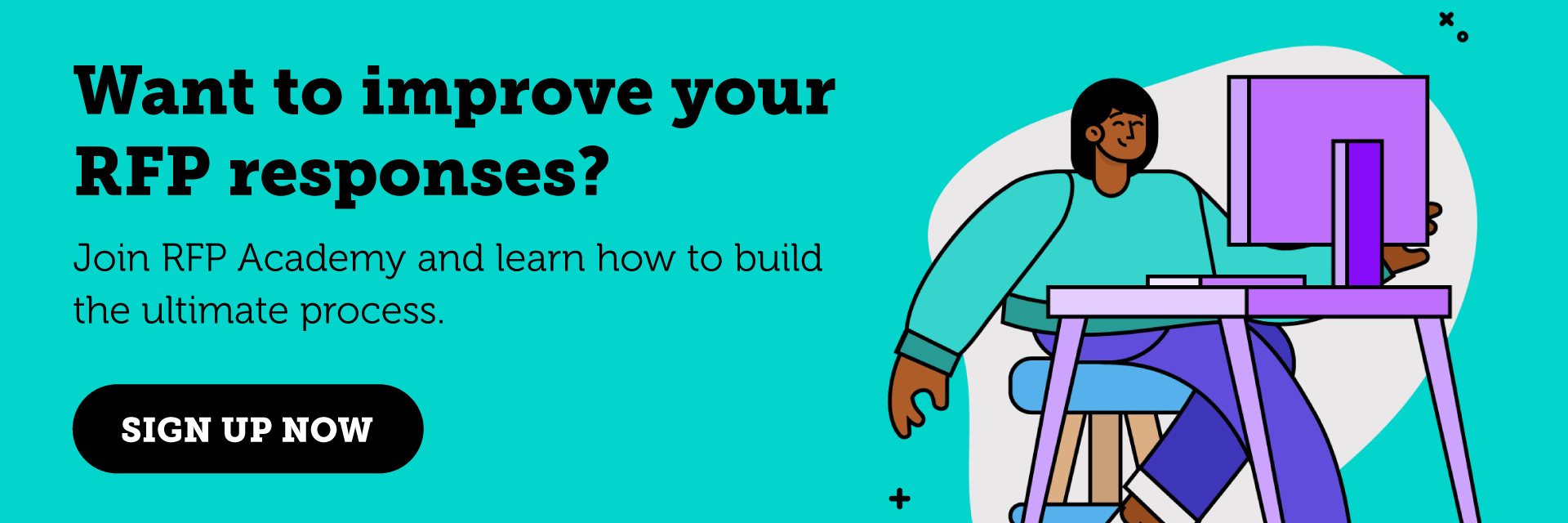The RFP response process is like a relay race—it’s a tense, fast-paced, and adrenaline-fueled team exercise. Any fumbled baton passes, needless back-and-forth, or confused teammates can cause you to miss a proposal deadline or—worse yet—lose a bid. Thankfully, learning how to respond to an RFP faster is something any organization or person can master. It’s all about building efficiencies into your process.
In this post, we’ll share how to respond to an RFP faster using seven tricks to speed up your response process. For each trick, we’ll share a short-term, “band-aid” fix to speed up your process today, as well as a long-term cure to fast-track your process for the future.
Follow These 7 Tricks for Responding to RFPs Faster
- Optimize Your RFP Intake
- Focus on the RFPs That Matter Most
- Get Your Execs and Key Stakeholders on Board
- Minimize the Workload for Your Subject Matter Experts (SMEs)
- Reduce Time Needed for Design
- Improve Collaboration Between RFP Writers
- Edit Smarter, Not Harder

1. Optimize Your RFP Intake
How to Respond to an RFP Faster Today
Designate an RFP lead. Ensure that everyone on the team knows that incoming RFPs should be sent straight to them. Make it their job to notify relevant stakeholders and kick off the proposal process. (Organizations with a dedicated RFP owner submit more RFPs on average than organizations without one. Here’s the research that proves it.)
How to Fast-Track Your Response Process for the Long Term
Create an RFP response process in Salesforce, Microsoft Dynamics, or your customer relationship management software (CRM) of choice (Google Forms will even do in a pinch). Use it to capture basic information about your next RFP and ensure the right people in the company are notified right away.
If your company already uses a CRM, you’ll likely need help from the person who administers it. We recommend recording:
✓ Company name
✓ Sales routing information (geographic region, vertical, and company size)
✓ Format for responding to the sales request (web-based portal, Excel spreadsheet, or Word document)
✓ Due date
✓ Prospect’s needs and potential key themes (i.e. Themes that differentiate from competitors)
2. Focus on the RFPs That Matter Most
How to Respond to an RFP Faster Today
Triage all your RFPs and cancel your responses to the least viable ones. Too often teams fall for the sunk cost fallacy—the idea that you’ve already invested resources into these RFPs, so you have to complete them. But, in reality, cutting dud RFPs loose will free up your time and attention for RFP responses that make the biggest difference to your business’s bottom line.
How to Fast-Track Your Response Process for the Long Term
Implement an ironclad decision matrix to prevent the duds from entering your RFP response pipeline in the first place. A decision matrix is a tool that scores an RFP’s viability based on key questions, allowing you to curate the ones you want to pursue (and have a chance of winning) while sifting out the ones that aren’t worth your time.
You can create your own or download our free decision template for RFPs.
3. Get Your Execs & Key Stakeholders on Board
How to Respond to an RFP Faster Today
Set expectations for everything up front. Make sure your execs and key stakeholders know what you expect from them from the get-go and have them confirm that they’ll be able to deliver by the required proposal date. Let them know you and your team will depend on them to hold up their side of the bargain—and if they can’t commit to helping you out, you’d rather know up front. Reiterate that your sales goals for the quarter are at stake.
How to Fast-Track Your Response Process for the Long Term
Map your process. There are templates and courses available online that can help you do this. The goal is to understand—and then reinforce to everyone involved—how many days it takes you to process an RFP, what the steps are, and whose input is required at each stage. Once you’ve established your RFP process, don’t deviate from it.
Need help getting started? Check out this 30-minute webinar for tips on building the ultimate RFP response process.
4. Minimize the Workload for Your Subject Matter Experts (SMEs)
How to Respond to an RFP Faster Today
If you’re short for time, have your SME record a short video or voice memo explaining their response instead of writing it. You can then generate a transcript of their answer using a program like Rev. It won’t be perfect, but with a few cosmetic edits to cut out their “ums” and smooth their sentence structure, it’ll do. Or, if you have more time, you can take a stab at the section yourself, and enlist your SME for fact-checking. Whichever method you choose, be sure to save a copy of the answer for use in future RFPs.
How to Fast-Track Your Response Process for the Long Term
Build a library of repurposable content for your winning RFP response. This will be easiest with a dedicated RFP response tool like Loopio, but Microsoft 365’s SharePoint or a shared Google Drive folder can also work as a temporary solution. Filling your library will take time, but the effort will be worth it. Eventually, you’ll be able to use your library of internal information and expertise to quickly pull together a rough draft and simply recruit your SMEs for review and fact-checking.
Start by adding answers from your most recent 5-10 proposals to your library. These answers will be the freshest, so they’ll be easiest to keep up to date. If there is any duplication between questions, pick whichever answer you think is strongest. Then, anytime you complete a new RFP, add the answer to your library.
5. Reduce Time Needed for Design
How to Respond to an RFP Faster
Go as minimal as possible. Find a template online that you can drop your written proposal content into or hire a freelancer who can work on a tight timeline. If you’re relying on an in-house designer, do a back-of-a-napkin type sketch of your idea so they can focus on retouching, rather than inventing from scratch.
How to Fast-Track Your Response Process for the Long Term
Build proposal templates and a library of images, charts, and icons. Just as you save written content in a library for future use, you should design your proposals with longevity in mind. While you might be personalizing proposals for different organizations, the kinds of audiences you’re targeting (your buyer personas) aren’t likely to change that much. Take some time to create an editable template in InDesign—or your layout tool of choice—that you can use and repurpose for different proposals.
6. Improve Collaboration Between RFP Writers
How to Respond to an RFP Faster Today
Use the ATFQ (answer the full question) method to make sure you’re responding appropriately to the questions being asked in the proposal. You should mirror the structure of the question in the first sentence of your answer. For instance, if the question is “how many people do you have in your organization?” the first line of your answer should be “our organization has x number of staff.” After you’ve clearly articulated your answer to the question, you can add supplementary details. If a question has multiple parts, be sure that you’re responding to each part within your answer.
How to Fast-Track Your Response Process for the Long Term
Create a content plan for each RFP response you write. This plan should outline your key proposal themes (the most persuasive reasons your prospect would choose your solution or product over a competitor) and sketch the broad lines of the story you want to tell. You can create this plan in whichever format makes sense for you—bullet points, a slide deck, or even a content storyboard—just make sure you share it with your SMEs and make sure they’re aligned on the plan before they start writing. This way, you’ll all be on the same page about the goals of your RFP response answers.
7. Edit Smarter, Not Harder
How to Respond to an RFP Faster Today
Designate a single person for quality assurance (QA). If your RFP responses tend to read like giant jigsaw puzzles, with contributors writing alternatively in bullet points, flowery language, and passive voice, you need someone to go through and enforce unity. Start by designating one person as a proofreader (ideally, someone who hasn’t been involved in the RFP response writing process, so they can approach the document with fresh eyes) who can synthesize your answers into a single, unified voice.
How to Fast-Track Your Response Process for the Long Term
Create an RFP response style guide for your company. This will help you achieve consistency and provide a single source of truth for your contributors and proofreaders. Your style guide can be basic at first—the goal is to create a living document that you can add to and expand on for future requests.
If you have existing brand guidelines, you can use these as the foundation. We recommend including guidance on things like:
- Positioning and messaging: What do you call your solutions externally? Are there specific names for different packages or features?
- Grammar and spelling: If you’re a multinational company, do you use American or British spelling?
- Tone of voice: How would you describe your organization’s voice? (e.g. “We’re fun, helpful, and laid-back” or “We’re knowledgeable, professional, and serious.”)
- Structure: What should an intro paragraph look like?
In order to thrive in the fast-paced RFP response race, your team needs to be nimble and coordinated. By implementing these strategies to maximize your RFP response efficiency, you’ll be well on your way to triumphantly crossing the finish line.
Want to learn more strategies to speed up your RFP response process? Check out our course.
